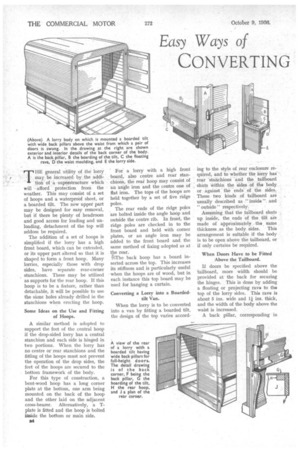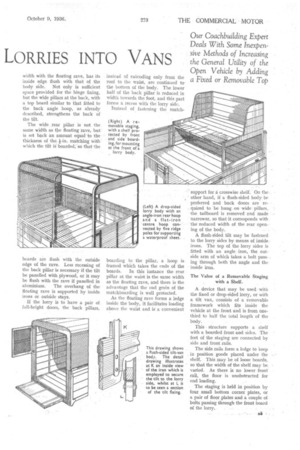Easy Ways of
Page 38

Page 39

If you've noticed an error in this article please click here to report it so we can fix it.
CONVERTING LORRIES INTO VANS
,
THE genera' utility of the' lorry may be increased by the addi tioii of 6, superstructure which will -afford protection from the weather. This may consist of a set of hoops and a waterproof sheet, or a boarded tilt. The new upper part may be designed for easy removal, but if there be plenty of headroom and good access for loading and unloading, detachment of the top will seldom be required.
The addition of a set of hoops is simplified if the lorry has a high front board, which can be extended, or its upper part altered so that it is shaped to form a front hoop. Many lorries, especially those with drop sides, have separate rear-corner stanchions. These may be utilized as supports for the rear hoop. H this hoop is to be a fixture, rather than detachable, it will be possible to use the same holes already drilled in the stanchions when erecting the hoop.
Some Ideas on the Use and Fitting of Hoops.
A similar method is adopted to support the feet of the central hoop if the drop-sided lorry has a central stanchion and each side is hinged in two portions. When the lorry has no centre or rear stanchions and the fitting of the hoops must not prevent the operation of the drop sides, the feet of the hoops are secured to the bottom framework of the body.
For this type of construction, a bent-wood hoop has a long corner plate at the bottom, one arm being mounted on the back of the hoop and the other laid on the adjacent cross-bearer. Alternatively, a Tplate is fitted and the hoop is bolted inside the bottom or main side. For a lorry with a high front . board, also centre and rear stan chions, the rear hoop may consist of an angle iron and the centre one of flat iron. The tops of the hoops are held together by a set of five ridge poles. The rear ends of the ridge poles are bolted inside the angle hoop and outside the centre rib. In front, the ridge poles are checked in to the front board and held with corner plates, or an angle iron may be added to the front board and the same method of fixing adopted as at the rear.
lAThe back hoop has a board inserted across the top. This increases its stiffness and is particularly useful • when the hoops are of wood, but in each instance this top board may be used for hanging a curtain.
Converting a Lorry into a Boardedtilt Van.
When the lorry is to be converted into a van by fitting a boarded tilt,
the design of the top varies accord
ing to the style of rear enclosure required, and to whether the lorry has rear stanchions and the tailboard shuts within the sides of the body or against the "ends of the sides. These two kinds of tailboard are usually described as "inside and " outside" respectively.
Assuming that the tailboard shuts up inside, the ends of the tilt are made of approximately. the same thickness as the body sides. This arrangement is suitable if the body is to be open above the tailboard, or if only curtains be required.
When Doors Have to be Fitted Above the Tailboard.
If doors be specified above the tailboard, more width should be provided at the back for securing the hinges. This is done by adding a floating or projecting rave to the top of the lorry sides. This rave is about 5 ins, wide and 11 ins, thick, and the width of the body above the waist is increased.
A back pillar, corresponding in width with the floating rave, has its inside edge flush with that of the body side. Not only is sufficient space provided for the hinge fixing, but the wide pillars at the back, with a top board similar to that fitted to the back angle hoop, as already described, strengthens the back of the tilt.
The wide rear pillar is not the same width as the floating lave, but is set back an amount equal to the thickness of the. Fin. matching with which the tilt irboarded, so that the boards are flush with the outside edge of the rave. Less recessing of the back pillar is necessary if the tilt be panelled with plywood, or it may be flush with the rave if panelled in aluminium. The overhang of the floating rave is supported by inside irons or outside stays.
If the lorry is to have a pair of full-height doors, the back pillars, instead of extending only from the roof to the waist, are continued to the bottom of the body. The lower half of the back pillar is reduced in width towards the foot, and this part forms a recess with the lorry side.
Instead of fastening the match
boarding to the pillar, a hoop is framed which takes the ends of the
boards. In this instance the rear pillar at the waist is the same width as the floating rave, and there is the advantage that the end grain of the matchboarding is well protected.
As the floating rave forms a ledge inside the body, it facilitates loading above the waist and is a convenient support for a crosswise shelf. On the other hand, if a flush-sided body be preferred and back doors are required to be hung on wide pillars, the tailboard is removed and made narrower, so that it corresponds with the reduced width of the rear opening of the body.
A flush-sided tilt may be fastened to the lorry sides by means of inside irons. The top of the lorry sides is fitted with an angle .iron, the outside •arm of which takes a bolt pass-.. ing through both the angle and the inside iron.
The Value of a Removable Staging with a Shelf.
A device that may be used with the fixed or drop-sided lorry, or with a tilt van, consists of a removable framework which fits inside the vehicle at the front and is from onethird to half the total length of the
body. .
This structure supports a shelf with a boarded front and sides. The feet of the staging are connected by side and front rails.
The side rails form a ledge to keep in position goods placed under the shelf. This may be of loose boards, so that the width of the shell may be varied. As there is to lower front rail, the floor is unobstructed for end loading.
The staging is held in position by four small bottom corner plates, or a pair of floor plates and a couple of bolts passing through the front board
of the lorry.




























































































